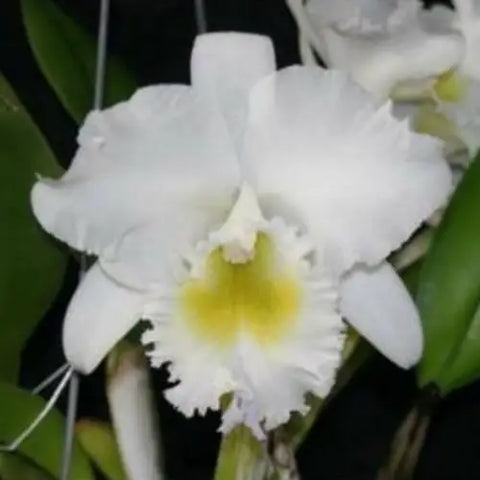
Bc. Pink Powder Puff (C. Nancy Off `Linwood' AM/AOS x Mount Hood `Mary' AM) Seedling 5" Pot
Bc. Pink Powder Puff (C. Nancy Off 'Linwood' AM/AOS × Mount Hood 'Mary' AM) – 5" Pot
Fragrant Seedling Hybrid with Award-Winning Pedigree and Giant Blooms
Brassocattleya Pink Powder Puff is a standout seedling hybrid that unites two of the most impressive and award-winning Cattleya parents: Cattleya Nancy Off 'Linwood' AM/AOS, known for producing stunning 8" white blooms, and Mount Hood 'Mary' AM, which bears up to 9" flowers in white or soft pink. Bred by L.Y. Nakanishi and registered by Waldor Orchids in 2022, this cross is designed to deliver massive, full, and fragrant flowers with classic cattleya style.
Each plant is grown from seed, so individual results will vary—making this an exciting hybrid for collectors. Blooms may range from light blush to deeper pinks, with rounded petals and ruffled lips inherited from both parents. The form is typically broad and well-proportioned, with excellent substance and texture. Flowers shown represent first blooms from this same cross, but color may and will vary from plant to plant.
This plant is blooming size and grown in a 5" pot. Expect blooming from late winter through early spring depending on your growing conditions.
Why Growers Love Bc. Pink Powder Puff
Growers love this hybrid for its enormous blooms, sweet fragrance, and the thrill of variation. Both parents are proven show-quality plants, and their size, substance, and bloom quality shine through in this cross. The hybrid’s flowers are impressively large—up to 9 inches in some cases—with a full, ruffled form and richly textured petals.
The fragrance is another standout trait—sweet and floral, particularly strong in the morning hours. And because this is a seedling cross, each plant has the potential to surprise you with unique color nuances. Whether you’re drawn to the pedigree, flower size, or the chance to raise something truly one-of-a-kind, Bc. Pink Powder Puff is a rewarding and visually stunning addition to any orchid collection.
Botanical Profile
-
Hybrid Name: Brassocattleya Pink Powder Puff
-
Parentage: C. Nancy Off 'Linwood' AM/AOS × Mount Hood 'Mary' AM
-
Registered By: Waldor Orchids (2022)
-
Pot Size: 5"
-
Growth Stage: Blooming Size (Seedling)
-
Bloom Size: 8"–9"
-
Color: Blush to deep pink; color may vary
-
Fragrance: Yes – sweet and floral, strongest in morning
-
Bloom Season: Late winter to early spring
-
Growth Habit: Medium to large epiphyte with thick pseudobulbs and leathery leaves
Cattleya Culture
Light:
Light is the most important factor for growing and blooming cattleyas. They love bright light—but not harsh, direct sun in the middle of the day. In your home, an east-facing window is ideal, or a shaded south or west window (use a sheer curtain if needed). In a greenhouse, aim for 50–70% full sun (about 3,000 to 5,000 foot-candles). A healthy Cattleya should have medium green leaves and stand upright without needing a stake.
Temperature:
Cattleyas like it warm during the day—about 70–85°F—and cooler at night—around 55–60°F. Seedlings do best with slightly warmer nights. A day/night difference of 15–20 degrees helps trigger blooming. They can handle up to 95°F if humidity and airflow are increased.
Watering & Humidity:
Watering depends on your pot size, media, temperature, and light levels. Mature plants need to dry out completely before the next watering. Seedlings prefer a bit more moisture. You can tell when it’s time to water by lifting the pot—light means dry, heavy means wet. When in doubt, wait a day. Never use water below 50°F, and avoid softened water with added salts.
Cattleyas enjoy humidity between 50–80%. At home, use a humidity tray with pebbles and make sure your pot doesn’t sit in the water. Airflow is key—moving air helps prevent disease. In greenhouses, use humidifiers or evaporative coolers to maintain proper moisture in the air.
Fertilizing:
Feed your cattleyas regularly. If you're growing in fir bark, use a high-nitrogen formula like 30-10-10. Otherwise, use a balanced fertilizer. During active growth, fertilize every two weeks. When growth slows, switch to once a month. You can also feed lightly (at ¼ strength) every time you water. Once a month, flush with plain water to wash out any salt buildup.
Repotting:
Repot every 2–3 years or when you see roots creeping over the edge or the potting mix breaks down. The best time to repot is right after blooming or in spring—just before new roots start to grow. Use coarser mix for mature plants, finer mix for young ones. Only divide a plant if it has at least 6 pseudobulbs. Each division should have 3–5 healthy bulbs. Pick a pot that allows for two years of new growth.
To repot:
-
Place fresh mix against one side of the new pot.
-
Trim any dead roots.
-
Lay the healthy roots on the mix with the cut rhizome against the pot wall.
-
Fill in and firm the mix around the roots.
-
Stake if needed.
-
Keep humid and shaded until you see new root growth.
We Also Recommend





